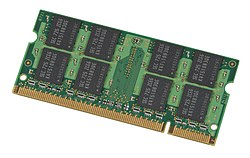DDR2 SDRAM
In information technologies we use the term DDR2 SDRAM for a Double Data Rate memory module of the second generation. This technology is used for high speed storage of the working data.
History
DDR2 was first made in 2001.
Comparisons
The main difference between DDR and DDR2 modules is that the bus on which the DDR2 memory modules are working is clocked at twice the speed of the memory cells. In practical terms we can say that four words of data can be transferred during one memory cell cycle. To sum it up DDR2 can effectively operate at twice the bus speed of DDR.
Specification standards
Chips and modules
For use in PCs, DDR2 SDRAM is supplied in DIMMs with 240 pins and a single locating notch. DIMMs are identified by their peak transfer capacity (often called bandwidth).
| Standard name | Memory clock | Cycle time | I/O Bus clock | Data transfers per second | Module name | Peak transfer rate |
| DDR2-400 | 100 MHz | 10 ns | 200 MHz | 400 Million | PC2-3200 | 3200 MB/s |
| DDR2-533 | 133 MHz | 7.5 ns | 266 MHz | 533 Million | PC2-4200 | 4266 MB/s |
| DDR2-667 | 166 MHz | 6 ns | 333 MHz | 667 Million | PC2-5300 | 5333 MB/s |
| DDR2-800 | 200 MHz | 5 ns | 400 MHz | 800 Million | PC2-6400 | 6400 MB/s |
| DDR2-1066 | 266 MHz | 3.75 ns | 533 MHz | 1066 Million | PC2-8500 | 8533 MB/s |




